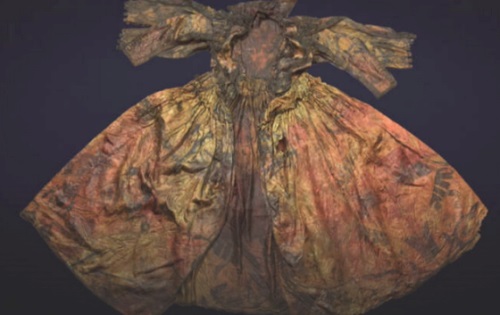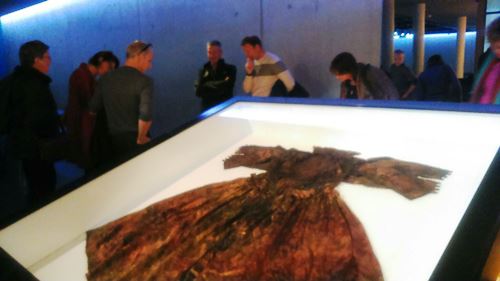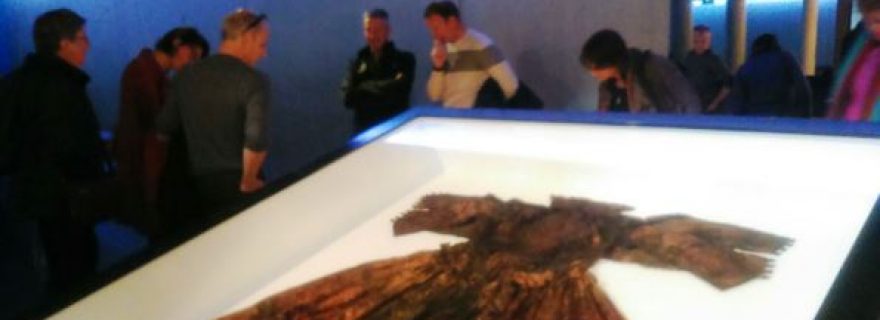Studying World Heritage in the Netherlands - Part 2
What can one learn from three days of fieldwork on Texel? As it turns out, quite a bit. Visiting the exhibition “Garde Robe” at Kaap Skil museum, I came across a successful example of a museum sharing its authority with members of the community.
Students from our Institute for Cultural Anthropology and Development Sociology as well as from a range of other departments recently went to the Dutch Wadden Island of Texel to study different aspects of the Wadden Sea as a UNESCO-recognized World Heritage Site. They present the results of their research projects on this student blog. I was the coordinator for the course Theory and Practice of Maintaining Cultural and Natural Heritage that this fieldwork was part of. In this capacity I was able to explore some of Texel’s heritage myself, such as the large yearly bonfire or “Meierblis” on April 30th. I was also lucky enough to catch the small exhibition “Garde Robe” at Kaap Skil museum, which ran from April 15 to May 16, 2016. This compact exhibition showcased some interesting museological techniques and seemed to be a successful example of a museum sharing its authority with members of the community.

The picture released on April 19, 2016 by the Museum Kaap Skil shows the 17th century silk dress found perfectly preserved in a shipwreck and displayed during the "Garde Robe" exhibition. Photo Museum Kaap Skil/AFP Photo.
The Dress
The “Garde Robe” exhibition was built around what has quickly become known as “The Dress”; an extraordinarily well preserved 17th-century dress that once belonged to an attendant of Queen Henrietta Maria of England. The dress, along with the rest of the lady’s luggage, was lost at sea when the ship carrying it perished in 1642 (for more information see the news on the documentary evidence about the dress and its owner). The dress and other articles of clothing are extremely well preserved, which makes the find one of great archaeological significance. For further explanation see this trailer for the Kaap Skill exhibition.
Official trailer of the Kaap Skill exhibition "Garde Robe".
The significance of the finding had clearly been impressed on the visitors to the exhibition. Almost all of them uttered something along the lines of “so, this is the dress, then!” as they came down the stairs from the entry hall of the museum to the exhibition hall. This spacious and relatively dark hall is usually reserved for the 3D model of the coast of Texel and objects relating to the island’s maritime history, all of which are still on display. For the occasion, a new glass case was positioned at the bottom of the stairs, which featured “The Dress” all by itself. The dress was spread out to its full size, displaying its expansive skirt and the voluminous sleeves to full effect. Behind the first glass case was a second one, broad, narrow and rectangular in shape, unlike the square case which housed the dress. In this second case, the visitor encountered some of the other kinds of objects that were found alongside the dress in the wreckage of the same ship. These objects include a clutch with silver-thread embroidery, leather book covers, stockings, navigational instruments, and ceramics.

The dress in Museum Kaap Skil.
The Exhibition
An interesting exhibition technique that was used in the “Garde Robe” exhibition was that the identification of the objects on display was written on the glass plate covering the display cases. This gave a distinctly low-key effect, which was reinforced by the brevity and informal tone of most of the notices: “part of a cape; consisted of 8 pieces, all recovered” [all translations by the author, from Dutch]. Whether or not this was intended by the makers of the exhibition, this way of labelling has the effect of drawing the visitor into the research on the objects, which is indeed ongoing. The handwritten notices, executed with a marker on glass and sometimes showing traces of having nearly been erased, seem to underscore the provisional nature of the knowledge about the objects in a way that printed labels or even touch screens do not.
The visitor reads “stockings, very finely knit; similar stockings have been found in Copenhagen and Stockholm, as well as another shipwreck off the coast of Texel. (Is the tree a “tree of life"?) and can easily imagine how this inscription beside the object will be erased and replaced with a more accurate assessment once further research emerges. The importance of comparison as a mode of scholarly inquiry is subtly brought out in the following note: “gilded silver lid, goblet (Mars, god of war, on lid: compare to cup of Maximilian)”. Even if this particular mode of presenting the objects with clearly impermanent markings on the display cases may have been be due to practical considerations, such as that the Kaap Skil exhibition was installed for only one month, the effect was still captivating and thought-provoking.

Handwritten notes on glass case in the “Garde Robe” exhibition at Museum Kaap Skil.
Sharing Authority
A second interesting aspect of the “Garde Robe” exhibition at Kaap Skil was the way the objects on display were brought to life for visitors by community members for whom the objects on display had special relevance. On both of my visits to the exhibition, on a Friday afternoon and a Sunday morning, the main case was flanked by a member of the “Texel Diving Club,” members of which first came upon the shipwreck where “the dress” was found. On both occasions, the pride of the diving-club members was obvious: they reveled in having made such a remarkable discovery, leading to international interest on the part of experts and the general public alike. Equally clear was the appreciation of visitors of the exhibition for what the divers could tell them about the conditions under which the ship and the dress had been discovered (on separate occasions, some five years apart).
In addition to answering many questions that were on people’s minds—how often do you dive in the Wadden Sea? How many other ships are there? What will happen to the dress when the exhibition is over? What will happen to the ship?—the divers also shared their experience of diving in conditions of extremely limited visibility, and of touching the cloth underwater, realizing it was a very different kind of material than they would normally encounter.
Again, I am not sure if the presence of divers to provide their personal perspectives on the objects of display was a consciously deployed museum technique. Nevertheless, the effect was that the special relevance of the objects to a particular group of community members became an integral part of the exhibition. Many of the visitors engaged to a greater or lesser extent with the diver standing next to the display cases, sometimes listening to his or her stories, sometimes asking questions. In the case of “Garde Robe,” then, the museum can be said to be sharing its authority, in that it allows its own way of presenting information—displaying a few chosen objects in two cases, with semi-ephemeral markers to indicate their context—to be supplemented by the meaning-making of the divers responsible for the discovery of the objects.
Despite the often-acknowledged need for museums to share some of their authority with relevant “other parties,” this is often not easy to pull off, in part because those attached to the objects on display voice opinions about them that do not fit easily with the museum’s scholarly paradigm. This came to the fore at the Kaap Skil museum too – as when, for example, one of the divers struggled to explain the archaeological insistence on “in situ” preservation (conserving archaeological objects where they are found, in this case under water). While acknowledging the scientific rationale for “in situ” preservation, the speaker’s own preference for not keeping the ship buried underwater indefinitely came through loud and clear.
The Future
Even if the exhibition is now closed, the hope is that the objects featured in “Garde Robe” will return to Texel to be on permanent display in the future. I will look forward to seeing these objects, and more from the same ship, displayed on the island once again. And I will be curious to see how many of the open-ended, dialogical, and personal exhibition techniques will be retained in the future permanent exhibit..



0 Comments
Add a comment